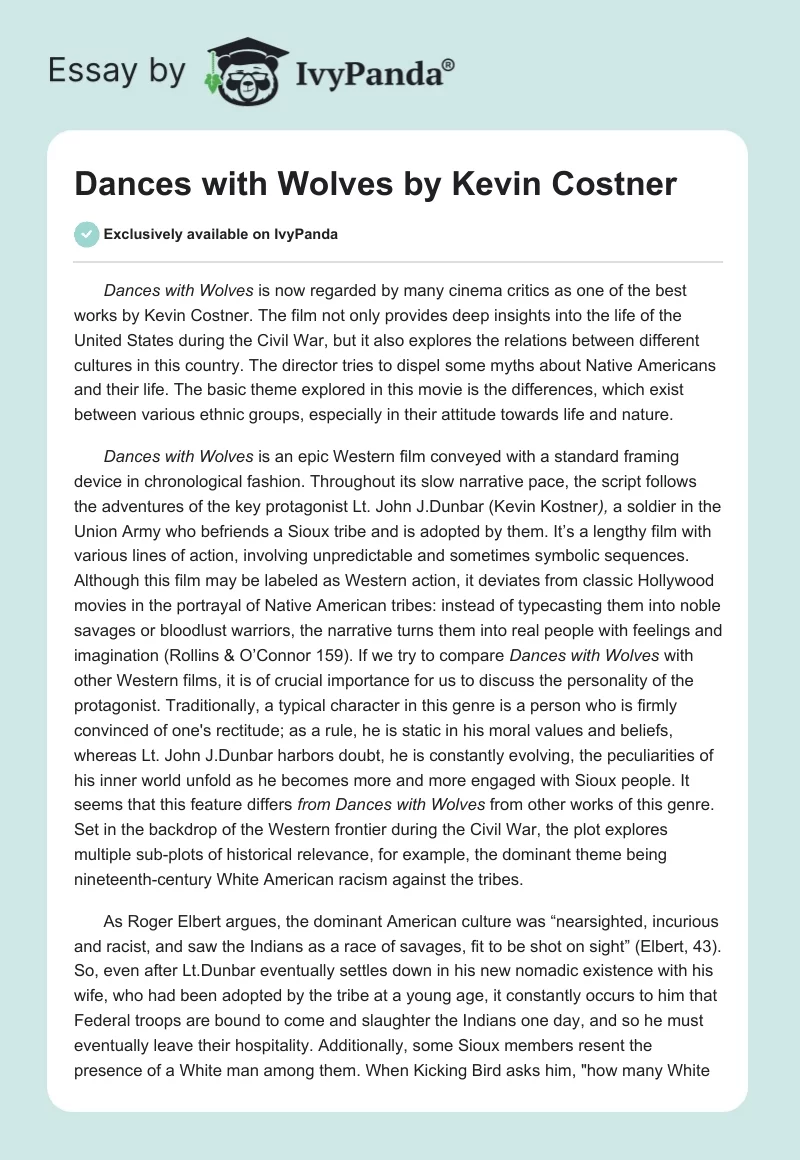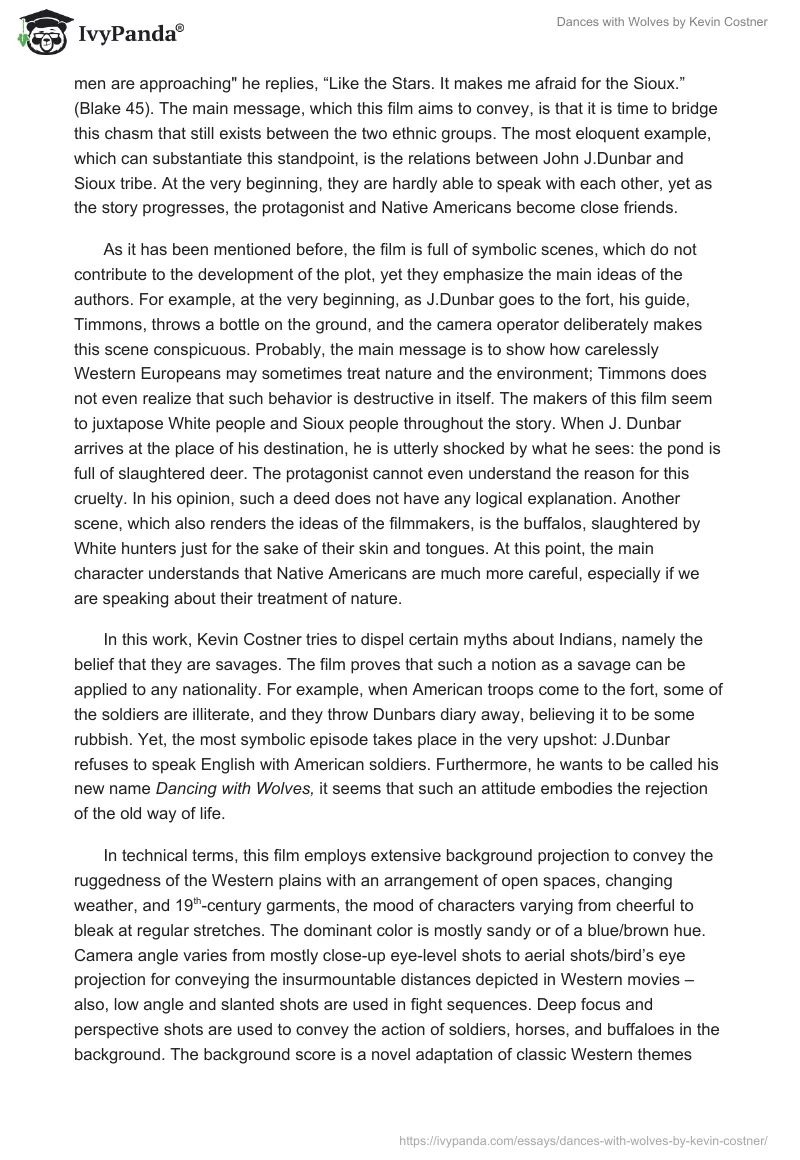Dances with Wolves is now regarded by many cinema critics as one of the best works by Kevin Costner. The film not only provides deep insights into the life of the United States during the Civil War, but it also explores the relations between different cultures in this country. The director tries to dispel some myths about Native Americans and their life. The basic theme explored in this movie is the differences, which exist between various ethnic groups, especially in their attitude towards life and nature.
Dances with Wolves is an epic Western film conveyed with a standard framing device in chronological fashion. Throughout its slow narrative pace, the script follows the adventures of the key protagonist Lt. John J.Dunbar (Kevin Kostner), a soldier in the Union Army who befriends a Sioux tribe and is adopted by them. It’s a lengthy film with various lines of action, involving unpredictable and sometimes symbolic sequences. Although this film may be labeled as Western action, it deviates from classic Hollywood movies in the portrayal of Native American tribes: instead of typecasting them into noble savages or bloodlust warriors, the narrative turns them into real people with feelings and imagination (Rollins & O’Connor 159). If we try to compare Dances with Wolves with other Western films, it is of crucial importance for us to discuss the personality of the protagonist. Traditionally, a typical character in this genre is a person who is firmly convinced of one’s rectitude; as a rule, he is static in his moral values and beliefs, whereas Lt. John J.Dunbar harbors doubt, he is constantly evolving, the peculiarities of his inner world unfold as he becomes more and more engaged with Sioux people. It seems that this feature differs from Dances with Wolves from other works of this genre. Set in the backdrop of the Western frontier during the Civil War, the plot explores multiple sub-plots of historical relevance, for example, the dominant theme being nineteenth-century White American racism against the tribes.
As Roger Elbert argues, the dominant American culture was “nearsighted, incurious and racist, and saw the Indians as a race of savages, fit to be shot on sight” (Elbert, 43). So, even after Lt.Dunbar eventually settles down in his new nomadic existence with his wife, who had been adopted by the tribe at a young age, it constantly occurs to him that Federal troops are bound to come and slaughter the Indians one day, and so he must eventually leave their hospitality. Additionally, some Sioux members resent the presence of a White man among them. When Kicking Bird asks him, “how many White men are approaching” he replies, “Like the Stars. It makes me afraid for the Sioux.” (Blake 45). The main message, which this film aims to convey, is that it is time to bridge this chasm that still exists between the two ethnic groups. The most eloquent example, which can substantiate this standpoint, is the relations between John J.Dunbar and Sioux tribe. At the very beginning, they are hardly able to speak with each other, yet as the story progresses, the protagonist and Native Americans become close friends.
As it has been mentioned before, the film is full of symbolic scenes, which do not contribute to the development of the plot, yet they emphasize the main ideas of the authors. For example, at the very beginning, as J.Dunbar goes to the fort, his guide, Timmons, throws a bottle on the ground, and the camera operator deliberately makes this scene conspicuous. Probably, the main message is to show how carelessly Western Europeans may sometimes treat nature and the environment; Timmons does not even realize that such behavior is destructive in itself. The makers of this film seem to juxtapose White people and Sioux people throughout the story. When J. Dunbar arrives at the place of his destination, he is utterly shocked by what he sees: the pond is full of slaughtered deer. The protagonist cannot even understand the reason for this cruelty. In his opinion, such a deed does not have any logical explanation. Another scene, which also renders the ideas of the filmmakers, is the buffalos, slaughtered by White hunters just for the sake of their skin and tongues. At this point, the main character understands that Native Americans are much more careful, especially if we are speaking about their treatment of nature.
In this work, Kevin Costner tries to dispel certain myths about Indians, namely the belief that they are savages. The film proves that such a notion as a savage can be applied to any nationality. For example, when American troops come to the fort, some of the soldiers are illiterate, and they throw Dunbars diary away, believing it to be some rubbish. Yet, the most symbolic episode takes place in the very upshot: J.Dunbar refuses to speak English with American soldiers. Furthermore, he wants to be called his new name Dancing with Wolves, it seems that such an attitude embodies the rejection of the old way of life.
In technical terms, this film employs extensive background projection to convey the ruggedness of the Western plains with an arrangement of open spaces, changing weather, and 19th-century garments, the mood of characters varying from cheerful to bleak at regular stretches. The dominant color is mostly sandy or of a blue/brown hue. Camera angle varies from mostly close-up eye-level shots to aerial shots/bird’s eye projection for conveying the insurmountable distances depicted in Western movies –also, low angle and slanted shots are used in fight sequences. Deep focus and perspective shots are used to convey the action of soldiers, horses, and buffaloes in the background. The background score is a novel adaptation of classic Western themes more suited to a 90’s audience. The pacing of the movie varies from dead slow (silent) to sudden action, which creates an effect of suspense. Subtleness is the most common ingredient of dialogues.
In conclusion, Dances with Wolves can be viewed as a ground-breaking Western film that does not follow one-dimensional stereotyping of Indians and depicts them as authentically as is possible. The makers of this film have achieved the effect they wanted to produce: they proved that some stereotypes about Native Americans are based on a common misconception. Furthermore, the makers of the movie illustrated that various ethnic groups could successfully co-exist in America.
References
Blake, Michael. Dances with Wolves. Fawcett Gold Medal, 1988: 45.
Rollins, Peter C. & O’Connor, John E. Hollywood’s Indian: The Portrayal of the Native American in Film. University Press of Kentucky, 1999: 159.
Ebert, Roger. “Review of Dances with Wolves”. Sun Times. 1990.
Canby, Vincent. “Review of Dances with Wolves”. New York Times. 1990.


